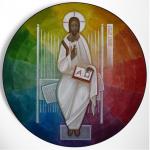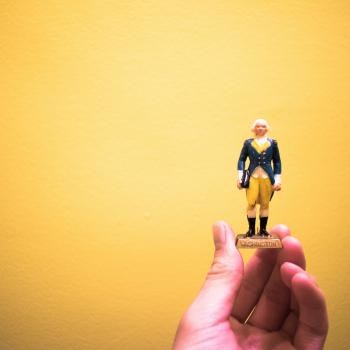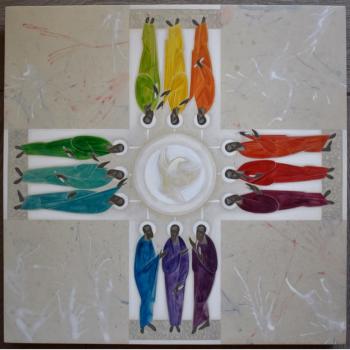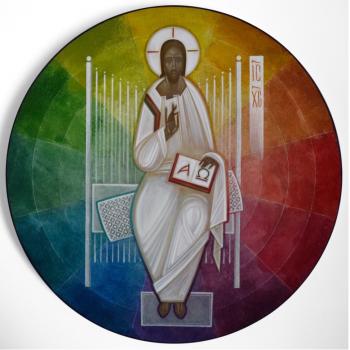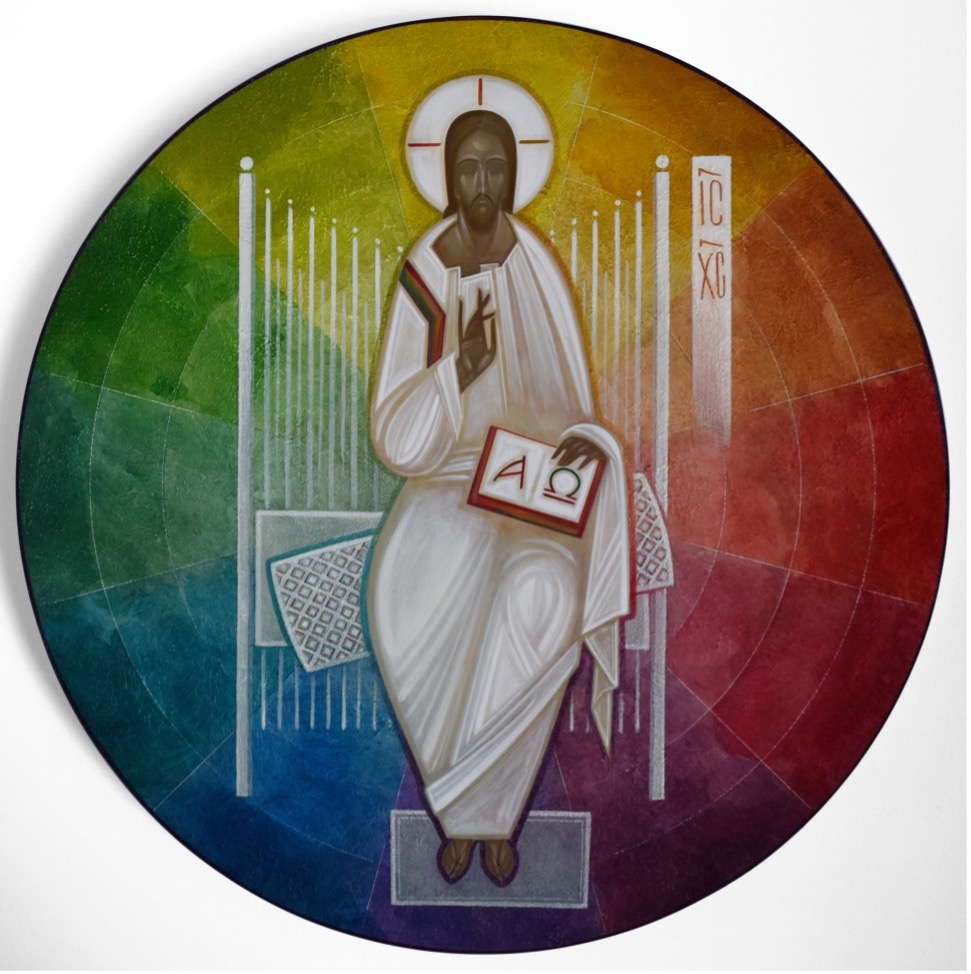
Visionings is a series that explores sight and seeing.
In the first installment, we considered the relationship between seeing and compassion. In the second installment, we will consider how religious iconography helps us to see God.
This claim, that icons help us to see God, may seem strange to us in the West but is absolutely central to the Eastern Church. I’ll be making the case over the next few pieces. The first will be a general introduction to icons. The second will be a practical guide to praying with icons. The third will highlight the work of a current iconographer, Khrystyna Kvyk, who’s work I’ve come to know and appreciate over the past year.
As we get started, I’ll set out a provisional definition of icons:
An icon is an image you look through to behold the beauty of the Lord. They are portals that, when contemplated with the eyes of faith, open the seer into communion with God.
Etymology: whence the word?
The word “icon” is the English transliteration of the Greek word eikon. According to BDAG, eikon has two primary meanings:
-
an object shaped to resemble the form or appearance of something, likeness, portrait
-
that which has the same form as something else (not a crafted object as in 1 above), living image…
The word appears just over 20 times in the Greek New Testament. It can mean something that looks like and/or represents something else. So, for instance, it can refer to a portrait of someone as in the emperor’s face imprinted on the Roman denarius (Luke 20:24). It can also refer to a representation of some created thing that is supplants the Living God (Rom 1:23).
In other contexts, eikon can also refer to a human being who is made in the image of God. In Genesis 1:26-28, we read that humans are created in the eikon of God. In the Ancient Near East, kings would often make images in the form of statues to represent themselves in places of their domains where they were absent. In making humans in his image, God has created living statues to represent himself in the world.
Perhaps most famously, Jesus is described using image language. St. Paul writes: “He [Jesus] is the image of the invisible God” (Col 1:15). Note: Paul is not saying that Jesus is made in the image – like every human being. Rather, Jesus is the image of God. Jesus is not a mere representation like the rest of us plebes.
Jesus is the icon of God. He is “the radiance of his glory and the exact imprint of his nature” (Heb 1:3). Jesus is The Image that is to be worshipped.
It’s important to say that the Greek word for image (eikon) is not the same as the word for idol (eidolon). If the Old Testament says anything, it says that idols are never OK and are not to be worshipped. In this series, I’ll be making the case that images/icons are not idols and may put to very good use when used faithfully.
History: whence the practice?
An increasing familiarity with practices like visio divina and resources like Contemplative Vision: A Guide to Christian Art and Prayer, has led some corners of the western church to be at least icon adjacent. But, by and large, icons remain an unfamiliar and untapped spiritual resource for most Christians in the West. We are strangers to icons, but this has not always been the case.
In fact, Eusebius, the early fourth century bishop and “father of church history,” suggests that religious icons were part of the life of the church from the earliest days. In The History of the Church, he recounts seeing a bronze statue of the scene from the gospels where Jesus heals the woman with a hemorrhage (Matt 9; Mark 5; Luke 8). He writes: “It is not at all surprising that Gentiles who long ago received such benefits from our Saviour should have expressed their gratitude thus, for the features of his apostles Paul and Peter, and indeed of Christ himself, have been preserved in coloured portraits which I have examined.” [1]
According to Leonid Ouspensky, an Orthodox theologian and expert in iconology, Eusebius’ testimony about images in the early church carries a great deal of weight because he was personally antagonistic to icons. In the first few centuries, Jews and Christians were immersed in pagan cultures marked by false worship and idols. “It was therefore natural,” Ouspensky writes, “that many Christians, both of Jewish and pagan origin, conscious of the negative experience of paganism, should strive to protect Christianity from the infection of idolatry.” [2] Despite these iconoclastic instincts in the early church, it is telling that there existed a tradition of religious iconography from the earliest days of the Christian movement.
Nevertheless, icons have been debated throughout history of church. This was especially during the 8th and 9th centuries. One on side, there is the pro-icon group known as iconodules (venerators of icons). On the other side, there is the anti-icon group known as iconoclasts (icon smashers). At the heart of the iconoclastic protest are concerns that the creation of icons contradicts the 2nd Commandment and that Christians who use icons for prayer are worshipping idols. This fire of this debate has never died.
Here is the classic reply to these concerns from Saint John of Damascus (675-749CE) in On the Divine Images:
For it we were to make an image of an invisible God, we would really sin; for it is impossible to depict one who is incorporeal and formless…if we were to make images of human beings and regard them and venerate them as gods, we would be truly sacrilegious. But we do none of these things. For if we make an image of God who in his ineffable goodness became incarnate and was seen upon earth in the flesh, and lived among humans, and assumed the nature and density and form and color of flesh, we do not go astray. [3]
The case Saint John of Damascus makes is an interesting one. The incarnation serves as the grounds for iconography. By becoming The Icon, the Church creates icons for the purpose of contemplating and communing with the one they represent. Implied in this statement, is the belief that it is never appropriate to create an image of God the Father. This is why God the Father is always represented as a Holy Angel in icons (just as in Old Testament theophanies), while Jesus and other saints are represented as themselves.
In 787AD, The Church rendered a decision on icons at the 7th Ecumenical Council, called the Second Council of Nicaea. They judged that use of icons is in line with the teaching and tradition of the Church:
just as the figure of the precious and life-giving Cross, so also the venerable and holy images, as well in painting and mosaic as of other fit materials, should be set forth in the holy churches of God, and on the sacred vessels and on the vestments and on hangings and in pictures both in houses and by the wayside, to wit, the figure of our Lord God and Saviour Jesus Christ, of our spotless Lady, the Mother of God, of the honourable Angels, of all Saints and of all pious people. For by so much more frequently as they are seen in artistic representation, by so much more readily are men lifted up to the memory of their prototypes, and to a longing after them; and to these should be given due salutation and honourable reverence, not indeed that true worship of faith which pertains alone to the divine nature; but to these, as to the figure of the precious and life-giving Cross and to the Book of the Gospels and to the other holy objects, incense and lights may be offered according to ancient pious custom. For the honour which is paid to the image passes on to that which the image represents, and he who reveres the image reveres in it the subject represented.[4]
However, as history shows, this was always a fragile consensus. The fracture over images has spread through church history to this very day. Icons have remained central to the worship and liturgy of the Orthodox Church but has gone into varying degrees of irrelevance and repudiation in the West.
Seeing new colors
I think that we in the West are missing out on a dimension of spiritual formation experienced by Orthodox Christians for centuries. Our vision of God is impoverished as a result. By branching out into other spiritual practices from other traditions, we just might behold new colors in the beauty of the Lord and enter greater depths of communion with God.
These sorts of practices are best caught, not taught – people are persuaded not by argument but experience. Towards that end, the next installment on icons will a practical guide to praying with them.
As Jim Forest argues in his essay in Beholding the Glory, the best way to understand iconography is connect John 1:14 and Colossians 1:15: “Christ the word is also Christ the Image: Logos and Ikon. He who became incarnate became the visible image of the invisible. And today we meet him not only with our ears but also with our eyes.” [5] We will see how icons are portals that can open the seer into communion with God.
—
[1] Eusebius, The History of the Church, Book VII, Ch 18 (Penguin Classics, 1990).[2] Leonid Ouspensky, The Meaning of Icons (SVS Press, 1999), 25.
[3] Saint John of Damascus, On the Divine Images (SVS Press, 2003), 82.
[4] from Fordham University’s Internet Medieval Source Book
[5] Jim Forest, Beholding the Glory (Baker, 2001), 84.


